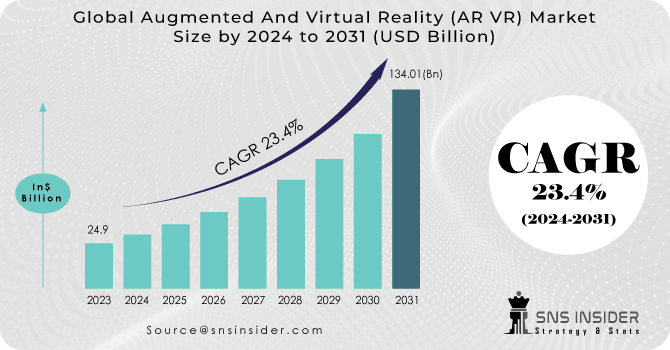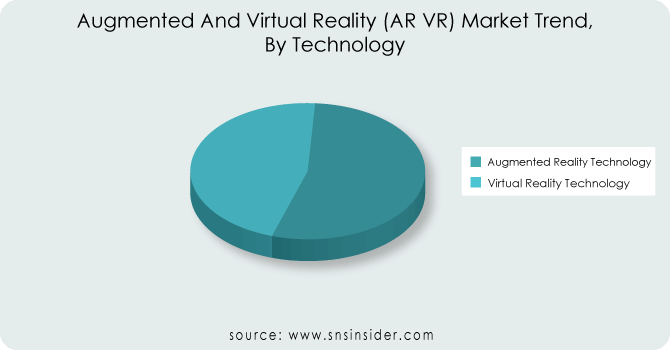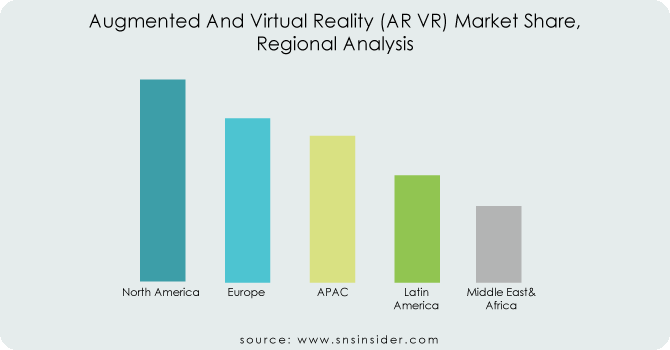The Augmented And Virtual Reality (AR VR) Market Size was valued at USD 24.9 Billion in 2023 and is expected to reach USD 134.01 Billion by 2031 and grow at a CAGR of 23.4 % over the forecast period 2024-2031.
Rising demand for AR and VR devices and applications is propelling the market forward. Rising demand for advanced devices in medical training, patient care management, and education is propelling the Augmented and Virtual Reality (AR VR) Market forward. The market growth is attributed to emerging trends in smart manufacturing. The Global Augmented and Virtual Reality (AR VR) Market report offers a comprehensive analysis of the market. The Growing in popularity of gaming, the cost-effective advantages of augmented and virtual reality solutions, and the increasing adoption of AR and VR technologies by enterprises are expected to Drive the Market.

Get more information on the Augmented and Virtual Reality (AR VR) Market - Request Sample Report
Drivers:
The AR and VR market experiences growth due to huge investments in creating innovative content and gaming experiences. These investments drive the development of captivating virtual worlds, immersive simulations, and interactive storytelling, attracting a broader audience across various sectors. Companies and developers focus on pushing boundaries in graphics, gameplay mechanics, and user engagement, leading to a competitive landscape that continually evolves with new and exciting offerings.
Restraints:
Opportunities:
The adoption of AR and VR for education and training purposes is growing. Virtual classrooms offer immersive learning experiences, simulations enable hands-on training in a safe environment, and skill development programs, interactive tools for effective learning outcomes. This trend is driven by the need for innovative and engaging learning methods, especially in remote or specialized fields. the institutions and businesses recognize the benefits of AR and VR in enhancing learning outcomes and skills acquisition, the market for educational and training applications continues to expand.
Challenges:
The ongoing Russia-Ukraine crisis has a multifaceted impact on the Augmented and Virtual Reality (AR & VR) market, affecting various facets of the industry. The market encounters obstacles such as security and privacy concerns associated with AR technologies and potential health issues linked to excessive use of AR & VR devices. Additionally, factors like display latency and energy consumption can impact the performance of AR & VR devices, potentially impeding market growth. the Russia-Ukraine conflict, and high inflation are also noteworthy, contributing to a complex operational landscape for AR & VR companies. These factors can disrupt supply chains, investment patterns, and global market dynamics, shaping both opportunities and challenges in the AR & VR market. the AR & VR market is navigating through a dynamic environment shaped by rapid technological advancements and significant geopolitical events. Despite the hurdles, ongoing innovation, and the widening applications of AR & VR technologies across diverse industries indicate a resilient growth path for the market.
The economic slowdown can have a significant impact. Reduced consumer spending may lead to decreased demand for AR/VR devices and experiences, impacting sales and revenue for companies in the industry. Businesses may also cut back on investments in AR/VR technologies, affecting innovation and development within the sector. The economic downturn could result in increased price sensitivity among consumers, making it challenging for AR/VR companies to maintain profitability and sustain growth.
By Technology
On the Basis Of Technology Virtual Reality Technology Dominates the Augmented And Virtual Reality (AR VR) Market with holding share of more than 58%, This dominance is attributed to VR's immersive nature, which creates entirely virtual environments for users to explore. VR headsets and systems offer highly realistic simulations and gaming experiences, Growing demand across entertainment, gaming, and training sectors. advancements in VR hardware and software have improved user comfort, visual quality, and interaction capabilities, further solidifying its market leadership. augmented reality (AR) technology is also gaining, especially in industries such as retail, healthcare, and manufacturing, offering interactive overlays on the real world for enhanced experiences and productivity.

Need any customization data on the Augmented and Virtual Reality (AR VR) Market - Enquiry Now
By Offering
By Enterprise
By Device Type
By Application
North America dominates the augmented and virtual reality market with a holding Revenue share of more than 31%, driven by high demand from sectors such as gaming, entertainment, media, aerospace and defense, retail, and manufacturing. Major industry players like Google, Facebook, and DAQRI are based in North America, offering cutting-edge solutions. Enterprises in this region have made significant investments in AR & VR technologies and simulation. The Asia-Pacific region is expected to grow with highest compound annual growth rate During the Forecast Period of 2024 to 2031. The introduction of 4G technology and high-speed communication, with the increasing number of smartphone users, has Driven the adoption of AR and VR technologies in this region. This trend is expected to continue in the forecast period.

REGIONAL COVERAGE:
North America
US
Canada
Mexico
Europe
Eastern Europe
Poland
Romania
Hungary
Turkey
Rest of Eastern Europe
Western Europe
Germany
France
UK
Italy
Spain
Netherlands
Switzerland
Austria
Rest of Western Europe
Asia Pacific
China
India
Japan
South Korea
Vietnam
Singapore
Australia
Rest of Asia Pacific
Middle East & Africa
Middle East
UAE
Egypt
Saudi Arabia
Qatar
Rest of the Middle East
Africa
Nigeria
South Africa
Rest of Africa
Latin America
Brazil
Argentina
Colombia
Rest of Latin America
The key players are Samsung Electronics Co., Ltd, Sony, Wikitude, HTC, Magic Leap, Inc, Microsoft Corporation, OSTERHOUT DESIGN GROUP, Alphabet, DAQRI, Facebook, and Other players.

In July 2023, Google and Taito are teaming up to develop Space Invaders, an immersive augmented reality (AR) game that allows players to defend the Earth right from their own neighborhoods. This exciting game is powered by our ARCore and Geospatial APIs, creating engaging levels in the real world using AR technology and 3D graphics on the screen, incorporating the player's immediate surroundings, nearby buildings, landscapes, and other architectural elements.
Apple made a groundbreaking announcement in June 2023 with the introduction of the Apple Vision Pro, a cutting-edge spatial computer that seamlessly blends digital content with the physical world, enabling users to stay connected and engaged with others. The Vision Pro provides a versatile platform for applications that go beyond traditional screens, featuring a fully three-dimensional user interface controlled by intuitive inputs such as a user's gaze, gestures, and voice commands.
Lenovo introduced the ThinkReality™ VRX in May 2023, an all-in-one virtual reality (VR) headset designed specifically for business use. Targeted at enterprises, the Lenovo ThinkReality VRX is tailored to be the ultimate VR solution for professionals in various fields. Whether it's improving employee training, facilitating virtual collaboration, or enhancing 3D design and engineering tasks, extended reality (XR) technologies are becoming increasingly important for businesses, empowering workers to achieve more.
| Report Attributes | Details |
|---|---|
| Market Size in 2023 | US$ 24.9 Billion |
| Market Size by 2031 | US$ 134.01 Billion |
| CAGR | CAGR of 23.4% From 2024 to 2031 |
| Base Year | 2023 |
| Forecast Period | 2024-2031 |
| Historical Data | 2020-2022 |
| Report Scope & Coverage | Market Size, Segments Analysis, Competitive Landscape, Regional Analysis, DROC & SWOT Analysis, Forecast Outlook |
| Key Segments | • By Technology (Augmented Reality Technology, Virtual Reality Technology) • By Offering (Hardware, Software) • By Enterprise (Small Enterprises, Medium Enterprises, Large Enterprises) • By Device Type (Augmented Reality Devices, Virtual Reality Devices) • By Application (Augmented Reality Application, Virtual Reality Application, Indoor Farms, Others) |
| Regional Analysis/Coverage | North America (US, Canada, Mexico), Europe (Eastern Europe [Poland, Romania, Hungary, Turkey, Rest of Eastern Europe] Western Europe] Germany, France, UK, Italy, Spain, Netherlands, Switzerland, Austria, Rest of Western Europe]), Asia Pacific (China, India, Japan, South Korea, Vietnam, Singapore, Australia, Rest of Asia Pacific), Middle East & Africa (Middle East [UAE, Egypt, Saudi Arabia, Qatar, Rest of Middle East], Africa [Nigeria, South Africa, Rest of Africa], Latin America (Brazil, Argentina, Colombia, Rest of Latin America) |
| Company Profiles | Samsung Electronics Co., Ltd, Sony, Wikitude, HTC, Magic Leap, Inc, Microsoft Corporation, OSTERHOUT DESIGN GROUP, Alphabet, DAQRI, Facebook, and other players. |
| DRIVERS | • AR Market COVID-19 is driving up demand for augmented reality in the retail and e-commerce sectors. Rising demand for augmented reality devices and applications in healthcare • VR Market Technological progress and increasing digitization HMDs are becoming more popular in a variety of industries. |
| RESTRAINTS | • AR Market AR-related security and privacy concerns Health risks associated with excessive AR use • VR Market The overall performance of VR devices is influenced by display latency and energy consumption. Health issues associated with low resolution and lack of movement |
Ans. The projected market size for the Augmented And Virtual Reality (AR VR) Market is USD 134.01 billion by 2031.
Viveverse, a cross-platform metaverse introduced by HTC Vive, is an open source VR metaverse comprising of multiple interactive environments, apps, and games. It allows users to move between platforms such as Vive Sync and Engage. also
Sony improved an existing product, the VR headset PSVR headset. Sony claims to be developing a PSVR headset for a better virtual reality experience on PlayStation, as the PSVR headgear will link directly to the PlayStation 5 console.
Ans: The Augmented And Virtual Reality (AR VR) Market is to grow at a CAGR of 25.5% during the forecast period 2023-2030.
Collaborations between telecom companies and AR manufacturers to reduce latency to undetectable levels and COVID-19 is driving up demand for VR HMDs in healthcare.
Rising demand for augmented reality devices and applications in healthcare
and HMDs are becoming more popular in a variety of industries.
Table of Contents
1. Introduction
1.1 Market Definition
1.2 Scope
1.3 Research Assumptions
2. Research Methodology
3. Market Dynamics
3.1 Drivers
3.2 Restraints
3.3 Opportunities
3.4 Challenges
4. Impact Analysis
4.1 COVID-19 Impact Analysis
4.2 Impact of Ukraine- Russia war
4.3 Impact of ongoing Recession
4.3.1 Introduction
4.3.2 Impact on major economies
4.3.2.1 US
4.3.2.2 Canada
4.3.2.3 Germany
4.3.2.4 France
4.3.2.5 United Kingdom
4.3.2.6 China
4.3.2.7 Japan
4.3.2.8 South Korea
4.3.2.9 Rest of the World
5. Value Chain Analysis
6. Porter’s 5 forces model
7. PEST Analysis
8. Augmented and Virtual Reality Market, by Organization Size
8.1 Large Enterprises
8.2 Small Enterprise & Medium-Sized Enterprises
9. Augmented and Virtual Reality Market, by Technology Type
9.1 AR Technology
9.1.1 Marker-based AR technology
9.1.2 Markerless AR technology
9.2 VR Technology
9.2.1 Non-Immersive
9.2.2 Semi-immersive and Fully Immersive Technology
10. Augmented and Virtual Reality Market, by Component
10.1 Hardware
10.2 Software
11. Augmented and Virtual Reality Market, by End-user Type
11.1 Commercial
11.2 Consumer
12. Augmented and Virtual Reality Market, by Application
12.1 Consumer
12.2 Commercial
12.3 Enterprise
12.4 Healthcare
12.5 Aerospace and Defence
12.6 Automotive
12.7 Energy
12.8 Others
13. Regional Analysis
13.1 Introduction
13.2 North America
13.2.1 USA
13.2.2 Canada
13.2.3 Mexico
13.3 Europe
13.3.1 Germany
13.3.2 UK
13.3.3 France
13.3.4 Italy
13.3.5 Spain
13.3.6 The Netherlands
13.3.7 Rest of Europe
13.4 Asia-Pacific
13.4.1 Japan
13.4.2 South Korea
13.4.3 China
13.4.4 India
13.4.5 Australia
13.4.6 Rest of Asia-Pacific
13.5 The Middle East & Africa
13.5.1 Israel
13.5.2 UAE
13.5.3 South Africa
13.5.4 Rest
13.6 Latin America
13.6.1 Brazil
13.6.2 Argentina
13.6.3 Rest of Latin America
14. Company Profiles
14.1 Samsung Electronics Co., Ltd
14.1.1 Financial
14.1.2 Products/ Services Offered
14.1.3 SWOT Analysis
14.1.4 The SNS view
14.2 DAQRI
14.3 Magic Leap, Inc
14.4 Sony
14.5 Wikitude
14.6 Alphabet (Google Inc.)
14.7 Microsoft Corporation
14.8 OSTERHOUT DESIGN GROUP
14.9 Facebook
14.10 HTC
15. Competitive Landscape
15.1 Competitive Benchmarking
15.2 Market Share Analysis
15.3 Recent Developments
16. Conclusion
An accurate research report requires proper strategizing as well as implementation. There are multiple factors involved in the completion of good and accurate research report and selecting the best methodology to compete the research is the toughest part. Since the research reports we provide play a crucial role in any company’s decision-making process, therefore we at SNS Insider always believe that we should choose the best method which gives us results closer to reality. This allows us to reach at a stage wherein we can provide our clients best and accurate investment to output ratio.
Each report that we prepare takes a timeframe of 350-400 business hours for production. Starting from the selection of titles through a couple of in-depth brain storming session to the final QC process before uploading our titles on our website we dedicate around 350 working hours. The titles are selected based on their current market cap and the foreseen CAGR and growth.
The 5 steps process:
Step 1: Secondary Research:
Secondary Research or Desk Research is as the name suggests is a research process wherein, we collect data through the readily available information. In this process we use various paid and unpaid databases which our team has access to and gather data through the same. This includes examining of listed companies’ annual reports, Journals, SEC filling etc. Apart from this our team has access to various associations across the globe across different industries. Lastly, we have exchange relationships with various university as well as individual libraries.

Step 2: Primary Research
When we talk about primary research, it is a type of study in which the researchers collect relevant data samples directly, rather than relying on previously collected data. This type of research is focused on gaining content specific facts that can be sued to solve specific problems. Since the collected data is fresh and first hand therefore it makes the study more accurate and genuine.
We at SNS Insider have divided Primary Research into 2 parts.
Part 1 wherein we interview the KOLs of major players as well as the upcoming ones across various geographic regions. This allows us to have their view over the market scenario and acts as an important tool to come closer to the accurate market numbers. As many as 45 paid and unpaid primary interviews are taken from both the demand and supply side of the industry to make sure we land at an accurate judgement and analysis of the market.
This step involves the triangulation of data wherein our team analyses the interview transcripts, online survey responses and observation of on filed participants. The below mentioned chart should give a better understanding of the part 1 of the primary interview.

Part 2: In this part of primary research the data collected via secondary research and the part 1 of the primary research is validated with the interviews from individual consultants and subject matter experts.
Consultants are those set of people who have at least 12 years of experience and expertise within the industry whereas Subject Matter Experts are those with at least 15 years of experience behind their back within the same space. The data with the help of two main processes i.e., FGDs (Focused Group Discussions) and IDs (Individual Discussions). This gives us a 3rd party nonbiased primary view of the market scenario making it a more dependable one while collation of the data pointers.
Step 3: Data Bank Validation
Once all the information is collected via primary and secondary sources, we run that information for data validation. At our intelligence centre our research heads track a lot of information related to the market which includes the quarterly reports, the daily stock prices, and other relevant information. Our data bank server gets updated every fortnight and that is how the information which we collected using our primary and secondary information is revalidated in real time.

Step 4: QA/QC Process
After all the data collection and validation our team does a final level of quality check and quality assurance to get rid of any unwanted or undesired mistakes. This might include but not limited to getting rid of the any typos, duplication of numbers or missing of any important information. The people involved in this process include technical content writers, research heads and graphics people. Once this process is completed the title gets uploader on our platform for our clients to read it.
Step 5: Final QC/QA Process:
This is the last process and comes when the client has ordered the study. In this process a final QA/QC is done before the study is emailed to the client. Since we believe in giving our clients a good experience of our research studies, therefore, to make sure that we do not lack at our end in any way humanly possible we do a final round of quality check and then dispatch the study to the client.
The Bluetooth 5.0 Market was worth USD 4.3 billion in 2022 and is predicted to be worth USD 9.78 billion by 2030, growing at a CAGR of 10.83 % between 2023 and 2030.
The Smart Grid Security Market size was valued at USD 7.63 billion in 2022 and is projected to reach USD 16.60 billion in 2030 with a growing CAGR of 10.21% Over the Forecast Period of 2023-2030.
The Telecom Billing and Revenue Management Market size was valued at USD 17.35 Bn in 2022 and is expected to reach USD 40.58 Bn by 2030, and grow at a CAGR of 11.2% over the forecast period 2023-2030.
The Metaverse in Education Market size was USD 3.0 billion in 2022 and is expected to Reach USD 39.0 billion by 2030 and grow at a CAGR of 37.8 % over the forecast period of 2023-2030.
The K-12 Testing and Assessment Market size was USD 11.5 billion in 2022 and is expected to Reach USD 21.6 billion by 2030 and grow at a CAGR of 8.21 % over the forecast period of 2023-2030.
Digital Signature Market Report Scope & Overview: Digital Signature Market size
Hi! Click one of our member below to chat on Phone